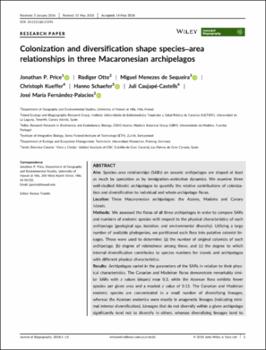Colonization and diversification shape species–area relationships in three Macaronesian archipelagos
Date
2018Abstract
Aim: Species–area relationships (SARs) on oceanic archipelagos are shaped at least
as much by speciation as by immigration–extinction dynamics. We examine three
well‐studied Atlantic archipelagos to quantify the relative contributions of colonization
and diversification to individual and whole‐archipelago floras.
Location: Three Macaronesian archipelagos: the Azores, Madeira and Canary
Islands.
Methods: We assessed the floras of all three archipelagos in order to compare SARs
and numbers of endemic species with respect to the physical characteristics of each
archipelago (geological age, isolation, and environmental diversity). Utilizing a large
number of available phylogenies, we partitioned each flora into putative colonist lineages.
These were used to determine: (a) the number of original colonists of each
archipelago, (b) degree of relatedness among these, and (c) the degree to which
internal diversification contributes to species numbers for islands and archipelagos
with different physical characteristics.
Results: Archipelagos varied in the parameters of the SARs in relation to their physical
characteristics. The Canarian and Madeiran floras demonstrate remarkably similar
SARs with z values (slopes) near 0.3, while the Azorean flora exhibits fewer
species per given area and a modest z value of 0.15. The Canarian and Madeiran
endemic species are concentrated in a small number of diversifying lineages,
whereas the Azorean endemics were mostly in anagenetic lineages (indicating minimal
internal diversification). Lineages that do not diversify within a given archipelago
significantly tend not to diversify in others, whereas diversifying lineages tend to have more species in the Canarian flora when compared with related lineages in the
others.
Main conclusions: Although a strong independent effect of island area on species
richness exists for the whole Macaronesian region, colonization and diversification
are also influenced by geological age and environmental diversity of archipelagos,
overriding characteristics of individual islands (“archipelago effect”). The “Azorean
diversity enigma” likely results from a combination of geological youth, low environmental
diversity and disproportionate human alteration.






